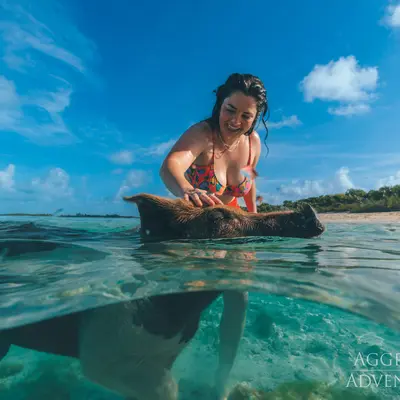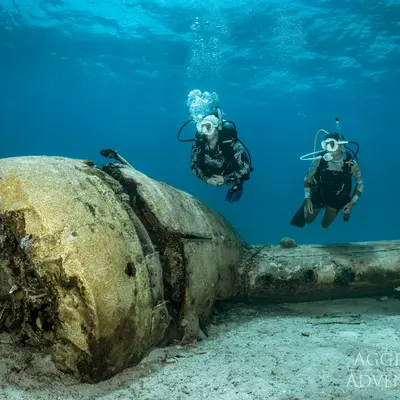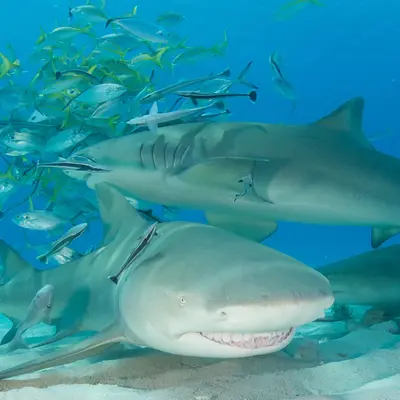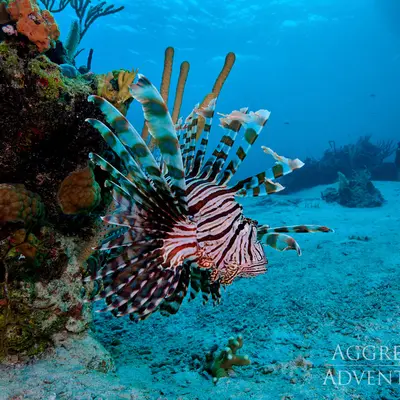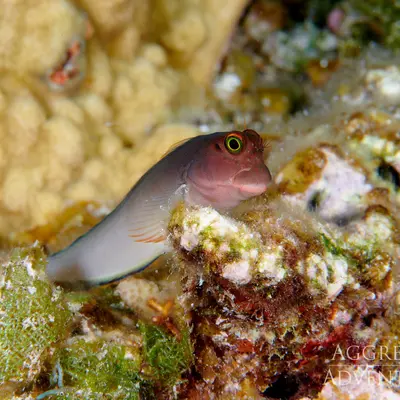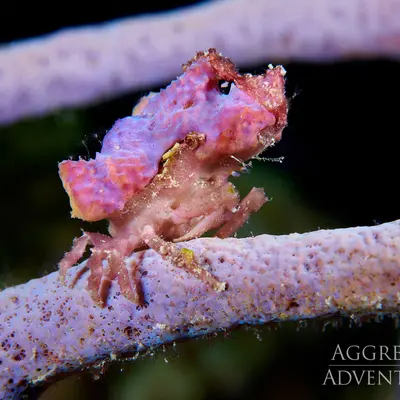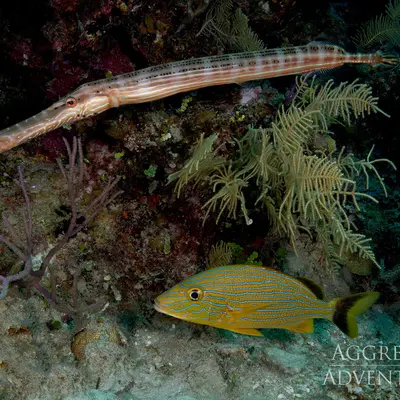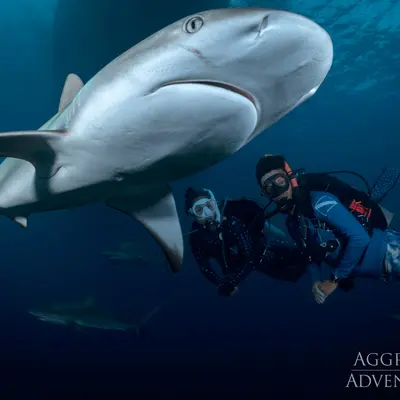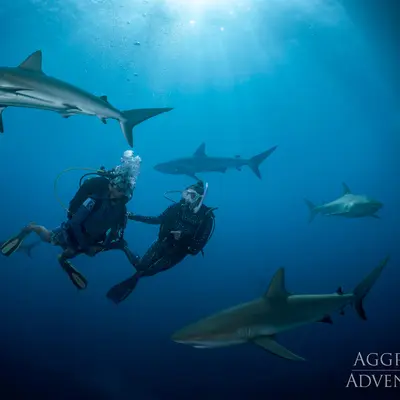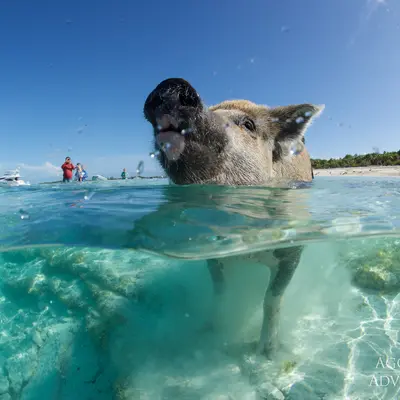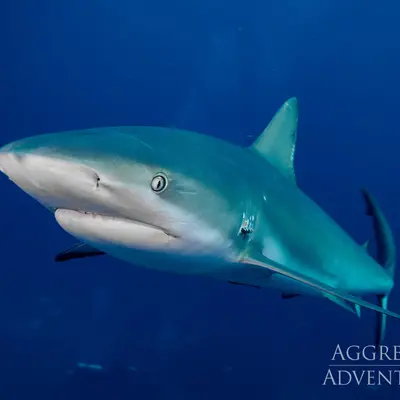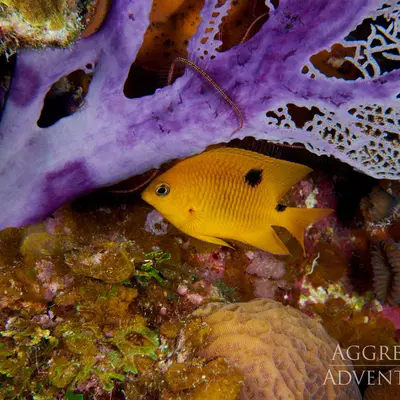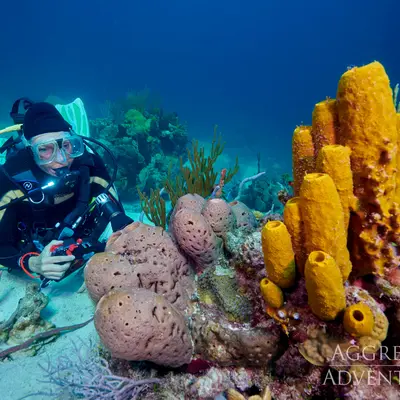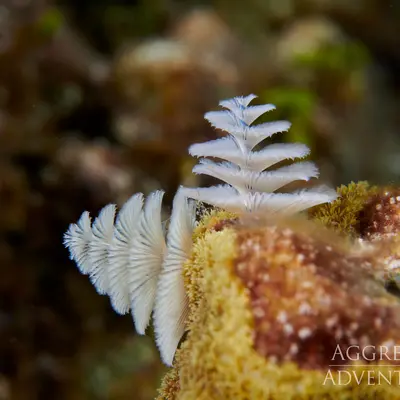Are you ready for the big adventure - sharks & co. await you
The Bahamas Aggressor II offers fascinating diving adventures in the crystal-clear waters of the Bahamas. Guests can look forward to evening activities, from fish identification presentations to films and games. Embarkation begins on Saturday afternoon in Nassau, with check-out the following Saturday morning.
Whether exploring the vibrant coral reefs, relaxing with a good book from the onboard library or enjoying the camaraderie of fellow divers, this liveaboard promises to be an unforgettable and enriching experience.
This website uses Google Maps to embed map material. Please note that your personal data may be collected in the process. To view the Google Maps map, please agree that it is loaded from the Google server.
The Bahamas Aggressor II is a 33.5 metre (110 foot) liveaboard that can accommodate up to 20 guests in a total of 10 cabins. There is a choice of two exclusive balcony suites with private outdoor areas, five deluxe cabins with flexible sleeping options and portholes, and three twin cabins with adjoining single beds. Each cabin is equipped with air conditioning, a private bathroom with shower, a television and a safe for personal valuables - for maximum comfort and privacy throughout the journey.
On board, guests have numerous amenities at their disposal, including an air-conditioned saloon with dining area, a spacious sun deck with whirlpool and sun loungers as well as a covered cocktail deck with barbecue facilities. For underwater photographers, there is a special camera table with low-pressure air hoses, a photo editing computer and an audio system in the outdoor area. Guests are spoilt with a varied selection of American and regional cuisine, including fresh seafood, homemade bread, exotic fruits and delicious grilled dishes. Coffee, soft drinks, local beer and wine are included in the price. Special dietary requirements are catered for where possible.
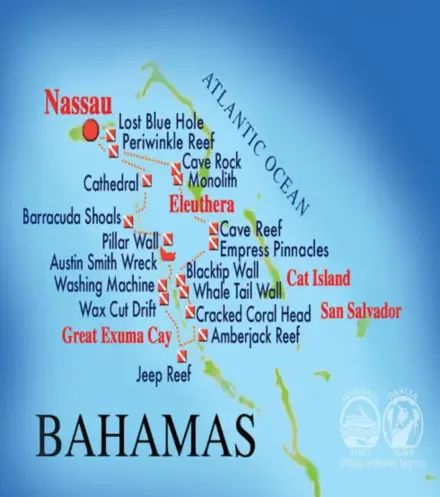
Exuma Cays and Southwest Eleuthera (Nassau - Nassau) 8D/7N
The Exumas consist of a series of more than 350 small islands and cays stretching from just 35 miles south of New Providence to the anchor islands of Great and Little Exuma to the south. The Exumas are a 120-mile long chain of islands within the Out Islands chain. The Cays are the most exotic of the Out Islands, a collection of tiny jewels nestled in the aquamarine and sapphire of the most beautiful waters you've ever imagined, with a mesmerising combination of walls and lush, shallow reefs.
Nassau
- Lost Blue Hole - The edge of this large blue hole lies in 40 feet of water, surrounded by coral heads, stingrays and many schools of fish. There is a lobster-filled crevice at 80'. In the sand surrounding the hole, divers will find many small fish such as banded jawfish, seminole gobies and tobacco fish. There are usually 1 or 2 nurse sharks here and in the spring a large school of blacknose sharks inhabit the bottom of the 200' hole. This is the place where the first lionfish were spotted in the Bahamas.
- Periwinkle Reef - This is a shallow reef that mates with fish. Local operators in Nassau feed fish here, so sergeant majors and angelfish approach divers looking for a handout.
Exumas
- Amberjack Reef - A 50-foot patch reef with a prolific fish population. You'll see reef sharks and up to 10 large groupers. This dive also has many interesting small creatures such as pirate blennies and garden eels. During the safety stop, divers will be surrounded by a school of 100+ horse-eye jacks hanging below the yacht.
- Austin Smith Wreck - A 90' Bahamian Defence Force cutter that was in 60' of water and sank in 1995 when it was towed to San Salvador to be scuttled as a dive site.
- Barracuda Shoals - This shore reef has huge schools of fish as well as many small creatures on the reef and in the surrounding sand.
- Blacktip Wall - Hammerhead sharks have been frequently spotted on this wall. This reef is also where Ned Deloach (co-author of Reef Books) found the very rare lemon goby.
- Cathedral - This site is part of the Dog Rocks Reef. This reef starts at 35' and drops down to 50' before dropping directly into Exuma Sound. Cathedral is a large swim through where the light bounces from the top to the bottom, reflecting off the thousands of silversides that occupy the swim through. This swim-thru has many grouper and mackerel feeding on the silversides. On the wall are large stands of black coral and orange elephant ears and tube sponges. Pelagics, eagle rays and sharks are often seen from the wall.
- Cracked Coral Head - This massive coral head rises 40' above the bottom. Several large passageways make it look like it has been cracked.
- Jeep Reef - Named after a coral-encrusted jeep that lies near the morning, this site is in the middle of Exumas Land & Sea Park and is home to a healthy population of fish. It's also one of the most beautiful reefs you'll ever see. The current that flows through this inlet keeps the reef's coral very healthy.
- Pillar Wall - One of many excellent wall dives. It starts at 30' and drops to 50' before dropping down 5,000'. There are many caves and crevices. There is a large colony of yellowhead jawfish in the rubble inside the reef.
Southwest Eleuthera
- Cave Rock - A large coral mound in 50 feet of water surrounded by several smaller coral heads. There are several caves where you can swim from one side to the other. The great variety of corals and fish will amaze you. Hammerhead sharks have often been spotted here.
- Monolith - Large coral mounds protrude from the sand at the edge of the wall. They start at 100' and rise to 55'. There is a colony of garden eels in the sand next to the mounds.
Little San Sal (Half Moon Cay)
- Cave Reef - This 40' shallow patch reef has several large passages cutting through the centre.
- Empress Pinnacles - This wall dive features 30' high pinnacles poking out of the sand at the edge of the wall. Pelagics are often seen in the clear water in front of the wall. There are large stands of black coral on the sides of the pinnacles.
Marine life: Sharks, eagle rays, stingrays, groupers, drop offs and reefs with a rich underwater world and several macro creatures
Double cabin with single beds lower deck
- 2 single beds
- Adjustable air conditioning
- En-suite bathroom
- max. 2 guests
Deluxe double cabin lower deck
- 1 double bed or 2 single beds
- Adjustable air conditioning
- En-suite bathroom
- max. 2 guests
Balcony Suite Upper Deck
- 1 double bed or 2 single beds
- Adjustable air conditioning
- En-suite bathroom
- max. 2 guests
Included:
VAT, alcoholic drinks, soft drinks, tea & coffee, drinking water, wine with dinner, snacks, full board (all meals), dive packages, cabin towels, complimentary toiletries.
Required extras:
Harbour fees (95-135 USD per trip).
Optional extras:
gratuities, airport transfer, hotel transfer, rental equipment, nitrox, nitrox course, diving courses, additional dives, snorkelling set.
Prices for rental equipment
Rental equipment is available on this ship. Please indicate on the booking form what you need. Details below of what is included and the additional prices.
- 15 litre tanks 75-120 USD per trip
- Regulators 60-90 USD per trip
- BCD 60-90 USD per trip
- Fin 50-75 USD per trip
- Mask 50-75 USD per trip
- Nitrox bottle 100-150 USD per trip
- Snorkelling set 50-75 USD per trip
- Torch 8 USD per day
- Dive computer 60-90 USD per trip
- U/W camera rental 100 USD
- Full equipment (with: regulator, BCD, fins, mask, torch, dive computer) 175-260 USD per trip
- Wetsuit 50-70 USD per trip
- Air temperature: Warm all year round with average temperatures between 22.3 °C in January and 28.0 °C in August.
- Water temperature: Stable temperatures between 24.5 °C in January/February and 29.0 °C in August/September, ideal for diving.
- Rainfall: Drier months from January to April; wetter period from May to October, with the highest rainfall in September.
The Bahamas are a group of islands in the Atlantic Ocean, consisting of over 700 islands and 2,400 coral reefs. They are located south-east of the USA (Florida) and north-east of Cuba and the Dominican Republic and are geographically part of the Caribbean.
Geographical location & climate
The climate is tropical maritime with warm temperatures all year round (average 24-30 °C). The islands are prone to hurricanes, especially between June and November.
Inhabitants & living conditions
The Bahamas have around 400,000 inhabitants, the majority of whom live on the most populous islands, including New Providence (Nassau, the capital) and Grand Bahama. The quality of life is high compared to other Caribbean countries, but the gap between rich and poor is wide.
Economy & livelihood
The economy is mainly based on tourism (over 60 % of GDP) and financial services. The Bahamas is a tax haven and a major offshore banking centre. Fishing and agriculture play a lesser role, but fish (especially conch shells) and seafood are important exports.
Religion & culture
Around 85% of the population are Christians, mainly Baptists, Anglicans and Catholics. The culture is strongly characterised by African, British and American influences. The Junkanoo Carnival, a colourful street festival with music and dancing, is one of the cultural highlights.
Position in the Caribbean
The Bahamas is considered one of the most prosperous countries in the Caribbean with a stable economy and government. They are an important hub for tourism, especially for cruise ships, and have close economic ties with the USA.
The Bahamas are therefore not only a paradise for holidaymakers, but also an economically important nation in the Caribbean!


